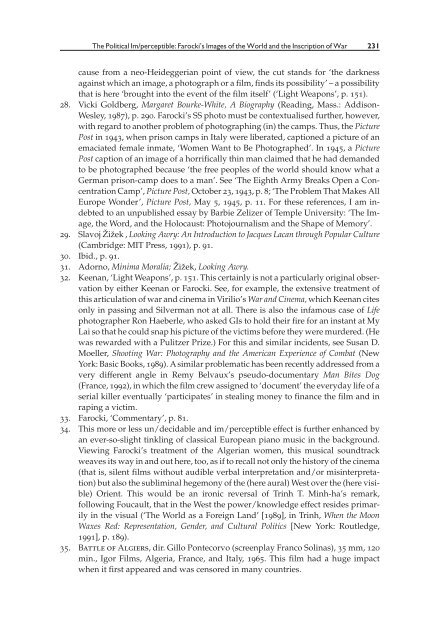You also want an ePaper? Increase the reach of your titles
YUMPU automatically turns print PDFs into web optimized ePapers that Google loves.
The Political Im/perceptible: Farocki’s Images of the World and the Inscription of War 231<br />
cause from a neo-Heideggerian point of view, the cut stands for ‘the darkness<br />
against which an image, a photograph or a film, finds its possibility’ – a possibility<br />
that is here ‘brought into the event of the film itself’ (‘Light Weapons’, p. 151).<br />
28. Vicki Goldberg, Margaret Bourke-White, A Biography (Reading, Mass.: Addison-<br />
Wesley, 1987), p. 290. Farocki’s SS photo must be contextualised further, however,<br />
with regard to another problem of photographing (in) the camps. Thus, the Picture<br />
Post in 1943, when prison camps in Italy were liberated, captioned a picture of an<br />
emaciated female inmate, ‘Women Want to Be Photographed’. In 1945, aPicture<br />
Post caption of an image of a horrifically thin man claimed that he had demanded<br />
to be photographed because ‘the free peoples of the world should know what a<br />
German prison-camp does to a man’. See ‘The Eighth Army Breaks Open a Concentration<br />
Camp’, Picture Post, <strong>October</strong> 23, 1943, p. 8; ‘The Problem That Makes All<br />
Europe Wonder’, Picture Post, May 5, 1945, p. 11. For these references, I am indebted<br />
to an unpublished essay by Barbie Zelizer of Temple University: ‘The Image,<br />
the Word, and the Holocaust: Photojournalism and the Shape of Memory’.<br />
29. Slavoj Žižek , Looking Awry: An Introduction to Jacques Lacan through Popular Culture<br />
(Cambridge: MIT Press, 1991), p. 91.<br />
30. Ibid., p. 91.<br />
31. Adorno, Minima Moralia; Žižek, Looking Awry.<br />
32. Keenan, ‘Light Weapons’, p. 151. This certainly is not a particularly original observation<br />
by either Keenan or Farocki. See, for example, the extensive treatment of<br />
this articulation of war and cinema in Virilio’s War and Cinema, which Keenan cites<br />
only in passing and Silverman not at all. There is also the infamous case of Life<br />
photographer Ron Haeberle, who asked GIs to hold their fire for an instant at My<br />
Lai so that he could snap his picture of the victims before they were murdered. (He<br />
was rewarded with a Pulitzer Prize.) For this and similar incidents, see Susan D.<br />
Moeller, Shooting War: Photography and the American Experience of Combat (New<br />
York: Basic Books, 1989). A similar problematic has been recently addressed from a<br />
very different angle in Remy Belvaux’s pseudo-documentary Man Bites Dog<br />
(France, 1992), in which the film crew assigned to ‘document’ the everyday life of a<br />
serial killer eventually ‘participates’ in stealing money to finance the film and in<br />
raping a victim.<br />
33. Farocki, ‘Commentary’, p. 81.<br />
34. This more or less un/decidable and im/perceptible effect is further enhanced by<br />
an ever-so-slight tinkling of classical European piano music in the background.<br />
Viewing Farocki’s treatment of the Algerian women, this musical soundtrack<br />
weaves its way in and out here, too, as if to recall not only the history of the cinema<br />
(that is, silent films without audible verbal interpretation and/or misinterpretation)<br />
but also the subliminal hegemony of the (here aural) West over the (here visible)<br />
Orient. This would be an ironic reversal of Trinh T. Minh-ha’s remark,<br />
following Foucault, that in the West the power/knowledge effect resides primarily<br />
in the visual (‘The World as a Foreign Land’ [1989], in Trinh, When the Moon<br />
Waxes Red: Representation, Gender, and Cultural Politics [New York: Routledge,<br />
1991], p. 189).<br />
35. Battle of Algiers, dir. Gillo Pontecorvo (screenplay Franco Solinas), 35 mm, 120<br />
min., Igor Films, Algeria, France, and Italy, 1965. This film had a huge impact<br />
when it first appeared and was censored in many countries.
















